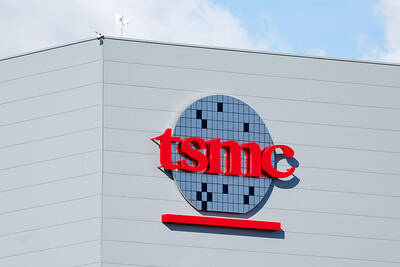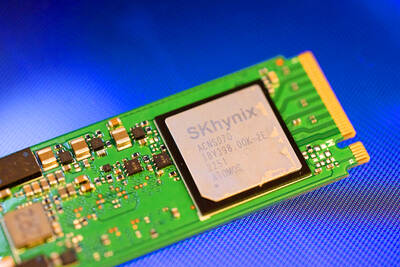China’s purchases of machines to make computer chips last month fell to their lowest level in more than two years, hammered by cratering electronics demand and new US export restrictions that are limiting the ability of Chinese firms to buy the most advanced equipment.
Chinese firms imported US$2.3 billion of machines used in semiconductor manufacturing last month, down by more than 40 percent from a year earlier to the lowest level since May 2020, according to customs data released on Wednesday.
Imports from the six major supplying nations, including the US, Japan and the Netherlands, all fell at a double-digit pace in the month, even before some of those nations agreed to join the US in further limiting shipments of the most advanced gear to China.

Photo: Reuters
Imports of computer chips also fell as makers of semiconductors for smartphones and PCs struggle with plummeting demand for their products less than a year after being unable to produce enough to meet orders.
The US sanctions announced in October have caused major foreign firms to limit or cease the supply to Chinese companies of equipment to make the most advanced chips, although machines used to make older and slower chips can still be shipped.
The US is negotiating with the Dutch and Japanese governments to convince them to join its unilateral sanctions, with people with knowledge of those talks telling Bloomberg that they are likely to adopt at least some of the sweeping measures of the US.
The three-country alliance would represent a near-total blockade of China’s ability to buy the equipment necessary to make leading-edge chips.
The US rules restricted the supply from US suppliers Applied Materials Inc, Lam Research Corp and KLA Corp.
Japan’s Tokyo Electron Ltd and Dutch lithography specialist ASML Holding NV are the two other critical suppliers that the US needs to make the sanctions effective, so if their governments adopt the curbs too, it would be a significant victory in the US attempt to cripple the development of China’s semiconductor industry.
China has filed a complaint with the WTO to try and overturn the export controls, although any decision on that would likely take years to be decided.
The trade data also showed that China’s purchases of computer chips were down by about 26 percent last month for a 2 percent decline in the first 11 months of this year.
Chinese demand for chips has been weak this year due to supply chain disruptions, a slowing domestic economy and falling demand globally for products such as smartphones.

Taiwan Semiconductor Manufacturing Co (TSMC, 台積電) secured a record 70.2 percent share of the global foundry business in the second quarter, up from 67.6 percent the previous quarter, and continued widening its lead over second-placed Samsung Electronics Co, TrendForce Corp (集邦科技) said on Monday. TSMC posted US$30.24 billion in sales in the April-to-June period, up 18.5 percent from the previous quarter, driven by major smartphone customers entering their ramp-up cycle and robust demand for artificial intelligence chips, laptops and PCs, which boosted wafer shipments and average selling prices, TrendForce said in a report. Samsung’s sales also grew in the second quarter, up

LIMITED IMPACT: Investor confidence was likely sustained by its relatively small exposure to the Chinese market, as only less advanced chips are made in Nanjing Taiwan Semiconductor Manufacturing Co (TSMC, 台積電) saw its stock price close steady yesterday in a sign that the loss of the validated end user (VEU) status for its Nanjing, China, fab should have a mild impact on the world’s biggest contract chipmaker financially and technologically. Media reports about the waiver loss sent TSMC down 1.29 percent during the early trading session yesterday, but the stock soon regained strength and ended at NT$1,160, unchanged from Tuesday. Investors’ confidence in TSMC was likely built on its relatively small exposure to the Chinese market, as Chinese customers contributed about 9 percent to TSMC’s revenue last

LOOPHOLES: The move is to end a break that was aiding foreign producers without any similar benefit for US manufacturers, the US Department of Commerce said US President Donald Trump’s administration would make it harder for Samsung Electronics Co and SK Hynix Inc to ship critical equipment to their chipmaking operations in China, dealing a potential blow to the companies’ production in the world’s largest semiconductor market. The US Department of Commerce in a notice published on Friday said that it was revoking waivers for Samsung and SK Hynix to use US technologies in their Chinese operations. The companies had been operating in China under regulations that allow them to import chipmaking equipment without applying for a new license each time. The move would revise what is known

UNCERTAINTY: A final ruling against the president’s tariffs would upend his trade deals and force the government to content with billions of dollars in refunds The legal fight over US President Donald Trump’s global tariffs is deepening after a federal appeals court ruled the levies were issued illegally under an emergency law, extending the chaos in global trade. A 7-4 decision by a panel of judges on Friday was a major setback for Trump, even as it gives both sides something to boast about. The majority upheld a May ruling by the Court of International Trade that the tariffs were illegal. However, the judges left the levies intact while the case proceeds, as Trump had requested, and suggested that any injunction could potentially be narrowed to apply